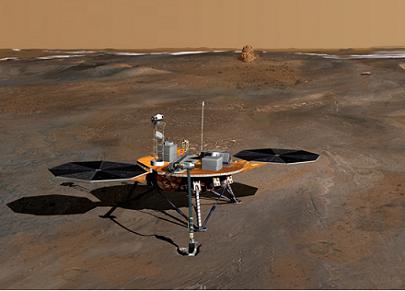NASA plans to launch the Phoenix Mars lander on Saturday, August 4 at noon Israel time

Tomorrow (Saturday) between 05:26 and 06:02 in the morning EST (between 12:26 and 13:02 Israel time), the Phoenix spacecraft is scheduled to take off to Mars. At a press conference, NASA's launch manager Chuck Duvall said that the launch team is ready for the scheduled date. Meteorological Officer Joel Tombiolo reported that the forecasted weather conditions for the launch date are good, with the probability of weather preventing the launch hovering around 20 percent. The forecast speaks of scattered clouds, light winds on the ground and at high altitude, and good visibility.
The launch continued as planned, except for the one-day delay caused by severe weather in the launch pad area on Tuesday, which prevented the Delta 2 launcher crew from completing the fueling of the rocket's second stage.
The Phoenix spacecraft will land in the polar regions of Mars and perform various research missions there, the most important of which is to examine whether the ice at the poles of Mars sometimes melts and turns into liquid water. The temperatures in the polar regions usually do not approach 0 degrees Celsius, but apparently various salts found in the Martian soil allow liquid water to exist on the surface of Mars. The great importance of the presence of liquid water on the surface of Mars is that its presence can indicate an environment suitable for the existence of life.
The Phoenix mission is to some extent reminiscent of the Viking missions which did not have movement capabilities (as opposed to Pathfinder which landed on Mars in 1996, Spirit and Opportunity which these days are still making waves on the surface of Mars for over 3 years) on the mission site You can be updated about the launch, watch animations and photographs of the preparation of the spacecraft and even read the blogs of the members of the mission team, you can even purchase t-shirts and mugs with the mission logo.
For hundreds of years, Mars has intrigued and challenged humans. In the last decade, every two years, spacecraft, orbiters and landers are launched towards Mars, which constitute many small steps. All of these are required for a huge step in which humans will walk on the surface of Mars for the first time, in a journey that will be the greatest human challenge ever.
Amir Barnett is an instructor at the Astronomy Center at Beit Tizif, at the Ilan Ramon Center for Youth Seeking Physics at Ben Gurion University of the Negev, a member of the Israel Astronomical Society.
In the coming days we will bring a series he wrote about the annoying email that has been circulating for the fourth year and claims to predict that on August 27 Mars will be as big as the moon, and in general about the history of the search for life on Mars.

11 תגובות
Mr. Columbus
According to what I know from physics
At an atmospheric pressure of 10 millibars, the water evaporates straight away and it doesn't matter what salts it contains.
By the way, the landing will take place in the North Pole area - and not at both poles...
Everyone also knows that water boils at 100 degrees Celsius and does not thaw at minus 50 degrees Celsius, but if you add different salts you can change these two parameters. People who are not aware of all the parameters and fixed in their perceptions warned Columbus not to fall off the edge of the world. Since none of us knows what all the parameters are, it is important to maintain a safe degree of openness.
In the article it is written that one of the missions of the spacecraft is to check:
Does the ice at the poles of Mars sometimes melt and turn into liquid water.
The pressure on the surface of Mars is 001 atmospheres or 10 millibars
If there was water at all, it would evaporate immediately, meaning there is no possibility of water on the surface of the star.
Could someone explain to me according to the article how there is water on the surface.
No manor, she won't come back. Why should she come back? It will transmit data from Mars to Earth and will be used by researchers until it is out of use.
Thanks for the article.
Response to Manor: I asked this question in one of the other articles about the Phoenix - and no, it will not come back. It will simply send the data to Earth until it is out of use.
Thanks for the article.
Will she return to Earth?
Thanks Amir for the fascinating update on this topic.